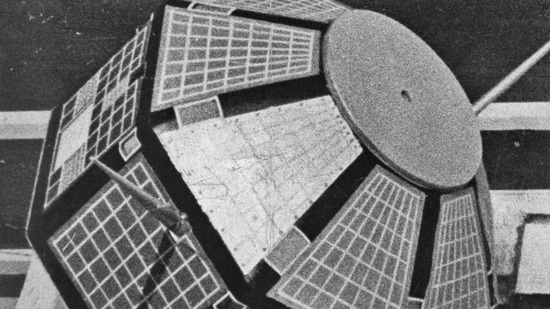When Aryabhata flagged off India’s journey into space
But, unknown at the time, those moments would go on to form the foundation on which a country builds formidable spacefaring capabilities.
Rockets developed inside an abandoned leaky church in Kerala, satellites assembled in brick sheds in an industrial section of Bangalore, and equipment worth millions transported on ox carts are images that have become synonymous with the early years of the Indian space programme between the 1960s and 1980s.

But, unknown at the time, those moments would go on to form the foundation on which a country builds formidable spacefaring capabilities. Today, India is among the few nations that have sent probes to the moon. In July 2019, the country also attempted to send its mission, Chandrayaan-2, to the previously unexplored South Pole of the moon.
On April 19, 1975, India shot its first satellite – Aryabhata -- into space atop a Soviet rocket, becoming the world’s 11th nation and the second developing country after China to orbit a satellite.
Built and assembled out of sheds in Peenya, Bangalore, the 360kg satellite was launched on a Soviet rocket, Kosmos-3M, from the Volgograd spaceport at Kapustin-Yar.
Its mission: X-ray astronomy for the detection and study of X-ray emission from outer space, study of solar neutron and gamma rays emanating from the sun, and study of aeronomy including ionosphere.
After the former Soviet Union and the US, launched their Sputnik and Explorer 1 satellites in 1957 and 1958, then Indian Space Research Organisation (Isro) chairman Dr Vikram Sarabhai wanted Indian scientists and engineers to join the satellite race. He picked Prof UR Rao to lead the mission.
Leading by the mantra of “if others can do, we can do better”, Rao led a team of about 300 Indian engineers to develop the satellite within 30 months.
While the initial plan was to build a small satellite and use the US’s Scout rocket to put it into orbit, the launch was conducted under a space cooperation agreement between India and the Soviet Academy of Sciences, signed by then Isro chair MGK Menon on May 10, 1972, which let India use the Soviet rocket free of cost.
“We had to have the first satellite which was an experimental satellite, learn the technology, understand the basics and move fast. So, when we were building Aryabhata, we were already thinking of modifying the control systems. We wanted to build a camera for remote sensing. So, we built Bhaskara-I and Bhaskara-II,” Rao told Frontline magazine in 2000 on the occasion of the silver jubilee of the mission.
Reporting on the launch, The New York Times quoted then Prime Minister Indira Gandhi describing it as “an important event in India’s efforts to harness the benefits of science”.
It was she who named the satellite Aryabhata after the fifth century Indian astronomer and mathematician, picking the name over two others – Maitri, to signify India’s bilateral relationship with Russia, then USSR, and Jawahar, after India’s first prime minister Jawaharlal Nehru.
“At this moment, thanks are due to the Soviet Union for its willing assistance and collaboration, and to France where one of the tracking stations is located; to those who brought India into the space age: Homi Bhabha, who had the dream; Vikram Sarabhai, who created the people and the instruments; and now Dr Satish Dhavan and his colleagues who have taken the first step into space with the promise of more to follow,” HT wrote in its edition of April 20, 1975.
The primary ground station for receiving data and commanding the satellite was set up at Sriharikota. A second ground station was built with help of the Soviet Academy of Sciences in Moscow for receiving data. To further increase data coverage, the French national Space Agency (CNES) provided the realtime telemetry reception and tracking of the satellite from the station of the French space network.
But, a power failure halted experiments after four days and 60 orbits, and only one payload could be operated for the first few days. The full mainframe of the satellite was operational until March 1981, with the ground station tracking the satellite for 17 years before its orbital life ended. The satellite re-entered the Earth’s atmosphere on February 11, 1992.
The country has come a long way since the launch of the first satellite.
A big milestone was achieved with Indian Air Force pilot Rakesh Sharma travelling to space as part of the Soviet Union’s Soyuz T-11 expedition on April 2, 1984.
Now, the space organisation has four big-ticket missions planned this year. These include the Gaganyaan mission which aims to send the first batch of Indian astronauts into space on an indigenously developed spacecraft; Aditya L1, India’s maiden mission to study the sun; Chandrayaan 3; and the development of a Small Satellite Launch Vehicle (SSLV).






